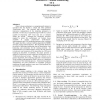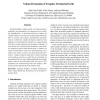VMV
2004
14 years 9 months ago
2004
In this paper we describe methods to efficiently visualize multiple intersecting volumetric objects. We introduce the concept of V-Objects. V-Objects repbstract properties of an o...
BILDMED
2007
14 years 9 months ago
2007
Abstract. We describe a new method to support the segmentation of a volumetric MRI- or CT-dataset such that only the components selected by the user are displayed by a volume rende...
116
click to vote
SI3D
1992
ACM
14 years 11 months ago
1992
ACM
Direct volume rendering is a computationally intensive operation that has become a valued and often preferred visualization tool. For maximal data comprehension, interactive manip...
VISUALIZATION
1997
IEEE
14 years 11 months ago
1997
IEEE
Different techniques have been proposed for rendering volumetric scalar data sets. Usually these approaches are focusing on orthogonal cartesian grids, but in the last years resea...
CGI
1999
IEEE
14 years 12 months ago
1999
IEEE
Rendering highly complex models can be time and space prohibitive, and decimation is an important tool in providing simplifications. A decimated model may replace the original ent...
VISUALIZATION
2000
IEEE
14 years 12 months ago
2000
IEEE
For a comprehensive understanding of tomographic image data in medical routine, interactive and high–quality direct volume rendering is an essential prerequisite. This is provid...
VISUALIZATION
2002
IEEE
15 years 12 days ago
2002
IEEE
While many methods exist for visualising scalar and vector data, visualisation of tensor data is still troublesome. We present a method for visualising second order tensors in thr...
103
click to vote
VISUALIZATION
2003
IEEE
15 years 23 days ago
2003
IEEE
Direct volume rendering of scalar fields uses a transfer function to map locally measured data properties to opacities and colors. The domain of the transfer function is typicall...
VIS
2009
IEEE
15 years 8 months ago
2009
IEEE
Direct volume rendering and isosurfacing are ubiquitous rendering techniques in scientific visualization, commonly employed in imaging 3D data from simulation and scan sources. Con...



